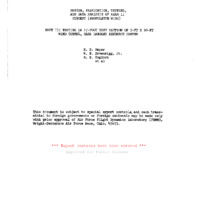-
Title
-
Design, Fabrication, Testing, And Data Analysis Of Adam II Concept (Propulsive Wing). Part III, Testing In 17 Ft Test Section Of 7 Ft X 10 Ft Wind Tunnel, Nasa Langley Research Center
-
Date
-
1968
-
Index Abstract
-
Coming Soon
-
Photo Quality
-
Not Needed
-
Report Number
-
AFFDL TR 68-31 Part 3
-
Creator
-
Brownrigg, William E., Jr.
-
English, Robert B.
-
Meyer, Robert D.
-
Corporate Author
-
LTV Aerospace Corp Dallas Tx Vought Aeronautics Div
-
Laboratory
-
Air Force Flight Dynamics Laboratory
-
Extent
-
101
-
Identifier
-
AD0832605
-
Access Rights
-
Export Controls
-
Distribution Classification
-
1
-
Contract
-
AF 33(615)-3293
-
DoD Project
-
1366
-
DoD Task
-
136617
-
DTIC Record Exists
-
No
-
Distribution Change Authority Correspondence
-
AFFDL LTR
-
Distribution Conflict
-
No
-
Special Scanning Requirements
-
Lots of fold out pages
-
Abstract
-
An analysis of selected data obtained from a low speed wind tunnel test of a straight, low aspect ratio propulsive wing V/STOL aircraft concept is presented. Essential features of the model are four compressed air tip driven fans in the wing with vectroable exhaust, fixed exhausts blwoing over the top of the flap simulating hot gas turbine exhaust, a forward-facing nose fan for pitch control with a vectorable exhaust, and tail surfaces mounted on booms extending aft as part of the wing tips. The model was tested in the V/STOL mode where the propulsive flows were defelected symmetrically downward by internal vanes at 30, 60, and 90 degrees and by flap deflections from 30 to 90 degrees. Stability, control, and a limited amount of pressure data were obtained for various flow deflections, momentum co-efficients, configuration changes, and ground board heights. Because of the proximity of the tails to the wing tip vortex, the horizontal tail contribution to the longitudinal stability is increased due to favorable upwash, and the directional stability contribution of the vertical tail is reduced due to high angles of sidewash. Removing the vertical tails from the booms and adding a centerline vertical tail to the fuselage improved directional stability and the linearity of the pitching moment curves. At high momentum coefficients, the high velocity propulsive flow induces additional dynamic pressure at the horizontal tails, and control effectiveness is improved. At low momentum coefficients the horizontal tail effectiveness is low. Control by deflectiion of the propulsive flow with wing vanes and flaps is adequate. In general, the effect of the ground board is to increase thrust-included lift by increasing bottom surface pressures and to reduce the effective exhaust flow deflection angle. Drag increments due to ground effects vary with vane and flap defelctions.
-
Report Availability
-
Full text available
-
Date Issued
-
1968-05
-
Provenance
-
Lockheed Martin Missiles & Fire Control
-
Type
-
report
-
Format
-
1 online resource
 AFFDLTR68-031part03.pdf
AFFDLTR68-031part03.pdf